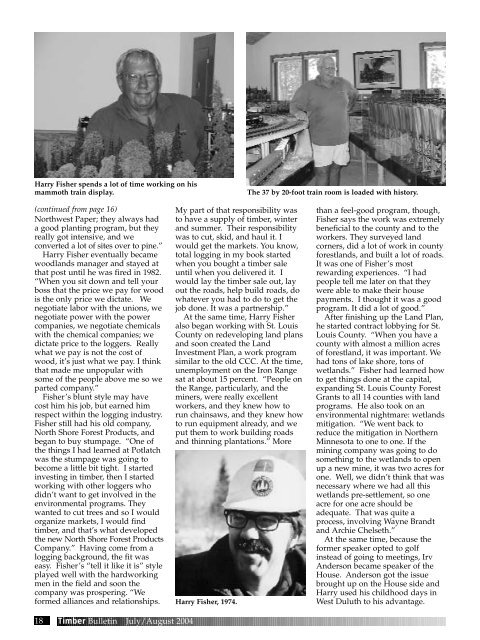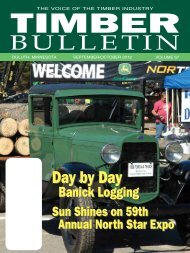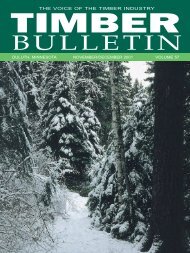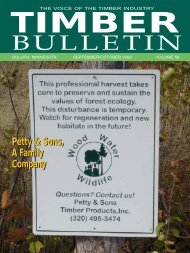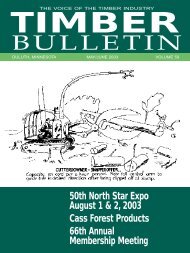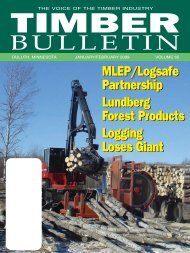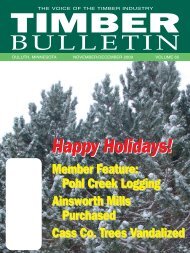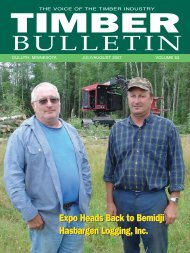Timber Bulletin Jul/Aug - Minnesota Forest Industries
Timber Bulletin Jul/Aug - Minnesota Forest Industries
Timber Bulletin Jul/Aug - Minnesota Forest Industries
Create successful ePaper yourself
Turn your PDF publications into a flip-book with our unique Google optimized e-Paper software.
Harry Fisher spends a lot of time working on his<br />
mammoth train display.<br />
The 37 by 20-foot train room is loaded with history.<br />
(continued from page 16)<br />
Northwest Paper; they always had<br />
a good planting program, but they<br />
really got intensive, and we<br />
converted a lot of sites over to pine.”<br />
Harry Fisher eventually became<br />
woodlands manager and stayed at<br />
that post until he was fired in 1982.<br />
“When you sit down and tell your<br />
boss that the price we pay for wood<br />
is the only price we dictate. We<br />
negotiate labor with the unions, we<br />
negotiate power with the power<br />
companies, we negotiate chemicals<br />
with the chemical companies; we<br />
dictate price to the loggers. Really<br />
what we pay is not the cost of<br />
wood, it’s just what we pay. I think<br />
that made me unpopular with<br />
some of the people above me so we<br />
parted company.”<br />
Fisher’s blunt style may have<br />
cost him his job, but earned him<br />
respect within the logging industry.<br />
Fisher still had his old company,<br />
North Shore <strong>Forest</strong> Products, and<br />
began to buy stumpage. “One of<br />
the things I had learned at Potlatch<br />
was the stumpage was going to<br />
become a little bit tight. I started<br />
investing in timber, then I started<br />
working with other loggers who<br />
didn’t want to get involved in the<br />
environmental programs. They<br />
wanted to cut trees and so I would<br />
organize markets, I would find<br />
timber, and that’s what developed<br />
the new North Shore <strong>Forest</strong> Products<br />
Company.” Having come from a<br />
logging background, the fit was<br />
easy. Fisher’s “tell it like it is” style<br />
played well with the hardworking<br />
men in the field and soon the<br />
company was prospering. “We<br />
formed alliances and relationships.<br />
My part of that responsibility was<br />
to have a supply of timber, winter<br />
and summer. Their responsibility<br />
was to cut, skid, and haul it. I<br />
would get the markets. You know,<br />
total logging in my book started<br />
when you bought a timber sale<br />
until when you delivered it. I<br />
would lay the timber sale out, lay<br />
out the roads, help build roads, do<br />
whatever you had to do to get the<br />
job done. It was a partnership.”<br />
At the same time, Harry Fisher<br />
also began working with St. Louis<br />
County on redeveloping land plans<br />
and soon created the Land<br />
Investment Plan, a work program<br />
similar to the old CCC. At the time,<br />
unemployment on the Iron Range<br />
sat at about 15 percent. “People on<br />
the Range, particularly, and the<br />
miners, were really excellent<br />
workers, and they knew how to<br />
run chainsaws, and they knew how<br />
to run equipment already, and we<br />
put them to work building roads<br />
and thinning plantations.” More<br />
Harry Fisher, 1974.<br />
than a feel-good program, though,<br />
Fisher says the work was extremely<br />
beneficial to the county and to the<br />
workers. They surveyed land<br />
corners, did a lot of work in county<br />
forestlands, and built a lot of roads.<br />
It was one of Fisher’s most<br />
rewarding experiences. “I had<br />
people tell me later on that they<br />
were able to make their house<br />
payments. I thought it was a good<br />
program. It did a lot of good.”<br />
After finishing up the Land Plan,<br />
he started contract lobbying for St.<br />
Louis County. “When you have a<br />
county with almost a million acres<br />
of forestland, it was important. We<br />
had tons of lake shore, tons of<br />
wetlands.” Fisher had learned how<br />
to get things done at the capital,<br />
expanding St. Louis County <strong>Forest</strong><br />
Grants to all 14 counties with land<br />
programs. He also took on an<br />
environmental nightmare: wetlands<br />
mitigation. “We went back to<br />
reduce the mitigation in Northern<br />
<strong>Minnesota</strong> to one to one. If the<br />
mining company was going to do<br />
something to the wetlands to open<br />
up a new mine, it was two acres for<br />
one. Well, we didn’t think that was<br />
necessary where we had all this<br />
wetlands pre-settlement, so one<br />
acre for one acre should be<br />
adequate. That was quite a<br />
process, involving Wayne Brandt<br />
and Archie Chelseth.”<br />
At the same time, because the<br />
former speaker opted to golf<br />
instead of going to meetings, Irv<br />
Anderson became speaker of the<br />
House. Anderson got the issue<br />
brought up on the House side and<br />
Harry used his childhood days in<br />
West Duluth to his advantage.<br />
18<br />
<strong>Timber</strong> <strong>Bulletin</strong> <strong>Jul</strong>y/<strong>Aug</strong>ust 2004


